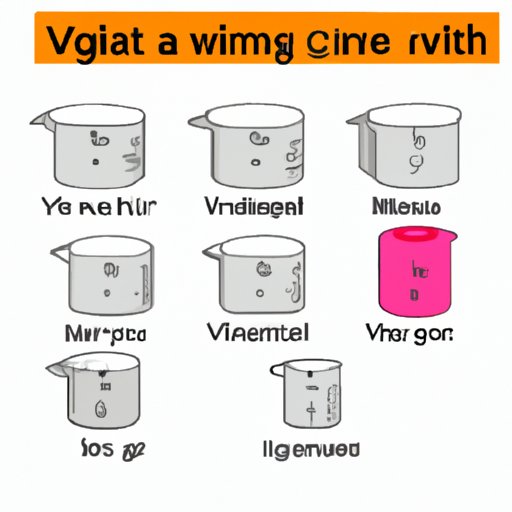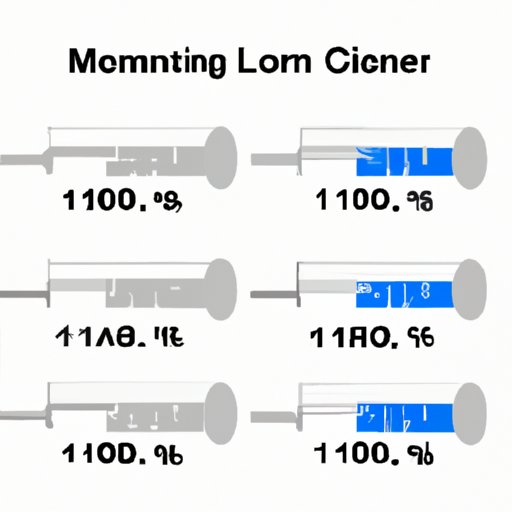I. Introduction
Converting 1g to ml can be a daunting task, especially for those unfamiliar with the metric system. However, understanding how to convert grams to milliliters is essential for accurate measurements in science and daily life. In this article, we will explore how to convert 1g to ml and provide some simple tricks to make the process easier.
II. Understanding Conversion: How to Convert 1g to ml
Before we dive into the conversion process, let’s define what 1g and ml are. Grams (g) are a unit of measurement for mass, while milliliters (ml) are a unit of measurement for volume. Converting between these two units is necessary when dealing with substances that have a specific density.
Conversion is vital in both science and daily life. In science, accurate measurements are crucial for experiments, calculations, and ensuring safety. In everyday life, we use measurements to cook, fill up a gas tank, or even calculate medication doses.
The formula for converting 1g to ml is relatively simple:
1g ÷ density = ml
To convert 1g to ml, you need to know the substance’s density. The density of a substance determines how much mass it has in a certain volume. The density of common substances can be found in reference tables or online.
III. Grams to Milliliters: A Comprehensive Guide
Some common substances and their densities are as follows:
| Substance | Density (g/ml) |
|---|---|
| Water | 1 |
| Milk | 1.03 |
| Alcohol | 0.79 |
| Olive oil | 0.92 |
| Sugar | 0.85 |
Using the above table, let’s try converting 1g of water to ml:
1g ÷ 1g/ml = 1ml
So, 1g of water is equal to 1ml. Using the same formula, you can convert 1g of any substance to ml as long as you know its density.
For example, let’s say we want to convert 1g of olive oil to ml:
1g ÷ 0.92g/ml = 1.09ml
So, 1g of olive oil is equal to 1.09ml.
To make the conversion process easier, try using online conversion calculators or apps that provide a wide range of substances and their respective densities.
IV. The Science Behind 1g to ml Conversion
The scientific concept behind converting grams to milliliters is density. Density is the amount of mass per unit volume. The formula for density is as follows:
Density (D) = Mass (M) ÷ Volume (V)
This formula explains the relationship between mass, volume, and density. Mass and volume are both essential quantities to measure substances, and density combines these two into one value. The density value is specific for every substance and is used to precisely convert between mass and volume units.
Specific gravity is another essential concept related to conversion. Specific gravity is the ratio of the density of a substance to the density of the standard substance (usually water). Specific gravity is a dimensionless quantity used to compare the density of different materials.
V. Simple Tricks to Quickly Convert 1g to ml
Here are some simple tricks to make converting 1g to ml a bit easier:
- Use a conversion table or calculator to save time and avoid mistakes.
- Remember that the density of a substance can change with temperature and pressure, so be sure to use the correct value.
- Round off the value to make it easier to measure, but be sure not to round too much, as it can affect accuracy.
- Use conversion factors, such as 1g = 1ml for water, to make conversions quicker.

VI. From Grams to Milliliters: Everything You Need to Know
One common mistake people make when converting 1g to ml is using the wrong density value. Make sure to use the correct substance density, as different materials have different densities. Another mistake is rounding off too much. Although rounding off helps with readability, it can affect the accuracy of the measurement. To ensure accuracy, use as many decimal places as possible.
Here’s another example to try: if we want to convert 1g of sugar with a density of 0.85g/ml to ml:
1g ÷ 0.85g/ml = 1.18ml
So, 1g of sugar is equal to 1.18ml.
To practice converting grams to milliliters further, try the following problems:
- Convert 1g of alcohol with a density of 0.79g/ml to ml.
- Convert 2g of milk with a density of 1.03g/ml to ml.
- Convert 3g of olive oil with a density of 0.92g/ml to ml.
VII. How to Accurately Convert 1g to ml (With Examples)
To accurately convert 1g to ml, follow these steps:
- Identify the substance’s density you want to convert.
- Write the density value as grams per milliliter (g/ml).
- Divide the mass, in grams (g), by the density, in grams per milliliter (g/ml), to find the volume, in milliliters (ml).
Here are some more example problems to try:
- Convert 5g of water with a density of 1g/ml to ml.
- Convert 10g of sugar with a density of 0.85g/ml to ml.
- Convert 15g of alcohol with a density of 0.79g/ml to ml.
Some common errors in conversion include using the wrong density value, rounding off too much, or not using enough decimal places.
VIII. The Conversion Conundrum: Demystifying 1g to ml
In conclusion, converting 1g to ml is a simple process once you understand the concept of density and have the correct substance density value. Using conversion tables, online calculators, or conversion factors can help make the process easier and save time. Remember to be careful when rounding off values and to use enough decimal places for accuracy.
Don’t hesitate to ask questions or seek further information. With accurate measurements, we can make more informed decisions in science and everyday life.
IX. Conclusion
In conclusion, converting 1g to ml is essential for accurate measurements in science and daily life. Through this article, we learned how to convert 1g to ml, the importance of the concept of density, and some simple tricks to make the process easier.
Always remember to use the correct density value and use enough decimal places for accuracy. With these steps, converting 1g to ml should be a breeze.
